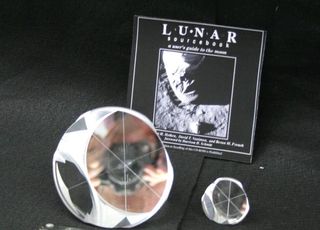An Indian spacecraft is carrying the first reflectors to be left on the moon since the Apollo era.
The reflectors, which are part of the Indian Space Research Organization's (ISRO) Chandrayaan-2 mission, which launched earlier this week, represent the next generation of an experiment that began in 1969.
50 years (and a few days) ago, the Apollo 11 astronauts left the Lunar Laser Ranging experiment on the moon. The experiment contained a tray of 100 small prisms that scientists on Earth would shoot with laser beams. Astronauts on Apollo 14 and 15 followed suit, leaving more of these prisms, known as retroreflectors, on the moon. Incredibly, decades later, these reflectors remain active experiments.
Related: Why Is the Apollo Reflector Experiment Still Operating, 50 Years Later?
By firing lasers at these reflectors, scientists on Earth observe the time it takes for the laser to return and can then study the distance between the moon and Earth. This helps scientists measure and analyze the moon's orbit, rotation, orientation and relationship with Earth. So far, these experiments have not only improved scientists' understanding of how the moon moves and how far we are from it but also helped to provide evidence that the moon has a liquid core.
However, while these decades-old experiments continue to function and provide scientists with accurate and useful data, the reflectors will soon be getting an upgrade. A team led by Principal Investigator Doug Currie, a senior research scientist and professor at the University of Maryland who was a key member of the team that designed the original Apollo reflectors, has designed a new laser retroreflector array to be landed on the moon. The new reflector, which was developed in conjunction with Co-Principal Investigator Simone Dell’Agnello, an Executive Technologist at the National Institute for Nuclear Physics - Frascati National Labs in Italy and researchers from the University of Maryland, is known as the Next Generation Lunar Retroreflector (NGLR).

The Next Generation Lunar Reflector (left) next to its Apollo-era predecessor (right).
(Image credit: Doug Currie)
The ISRO launched this new reflector to the moon's south pole Monday (July 22) on board Chandrayaan-2's Vikram lander. The NGLR is different from its predecessors in that, in addition to being destined for a new location on the moon, it's designed to be more accurate.
The team behind the NGLR aims for the experiment to have a hundredfold improvement in accuracy. To do so, it features improved reflectors and uses more of them over a larger area on the moon than previous reflectors did, according to a statement from the University of Maryland.
The "next-gen retroreflectors are much more compact and lighter than Apollo’s meter-size arrays deployed by Apollo 11, 14 and 15 astronauts," Dell’Agnello added in an email to Space.com. They further explained that the NGLR is a "microreflector," a singular, 4-inch-diameter single retroreflector. This is much different from Apollo's array of a hundred 1.5-inch-diameter retroreflectors.
"Our Next Generation Lunar Retroreflector is a 21st-century version of the instruments currently on the moon," Currie said in the statement. "Each placement of a Next Generation lunar laser ranging array will greatly enhance the scientific and navigational capabilities of retroreflector network. These additions improve the mapping and navigation capabilities important for NASA's plans to return to the moon and by 2028 establish a sustained human presence."
The reflectors will help scientists to investigate other areas of science as well. For example, scientists will use the reflectors to conduct new tests regarding general relativity and related theories, which may help to reveal more about dark matter, the mysterious stuff that makes up almost 27% of the universe, Currie said.
"Plus," Dell’Agnello added, "laser retroreflectors will serve surface geodesy, lunar cartography, exploration, ISRU and various forms of future lunar (and/or martian) commerce that will need surface metric measurements. Applications that already happened on Earth since the dawn of urbanization."
The NGLR is one of 12 investigations that NASA has selected for study and exploration of the moon as part of the agency's Artemis lunar program. The experiments and demonstrations "will help the agency send astronauts to the Moon by 2024 as a way to prepare to send humans to Mars for the first time," NASA officials said in a statement.
Follow Chelsea Gohd on Twitter @chelsea_gohd. Follow us on Twitter @Spacedotcom and on Facebook.
Bagikan Berita Ini














0 Response to "India's Chandrayaan-2 Is Carrying a Next-Generation Apollo Experiment to the Moon for NASA - Space.com"
Post a Comment